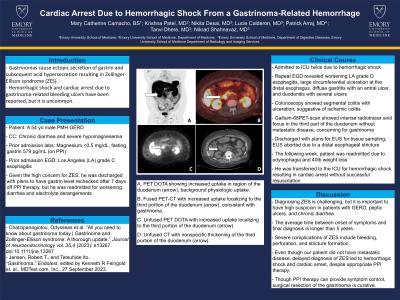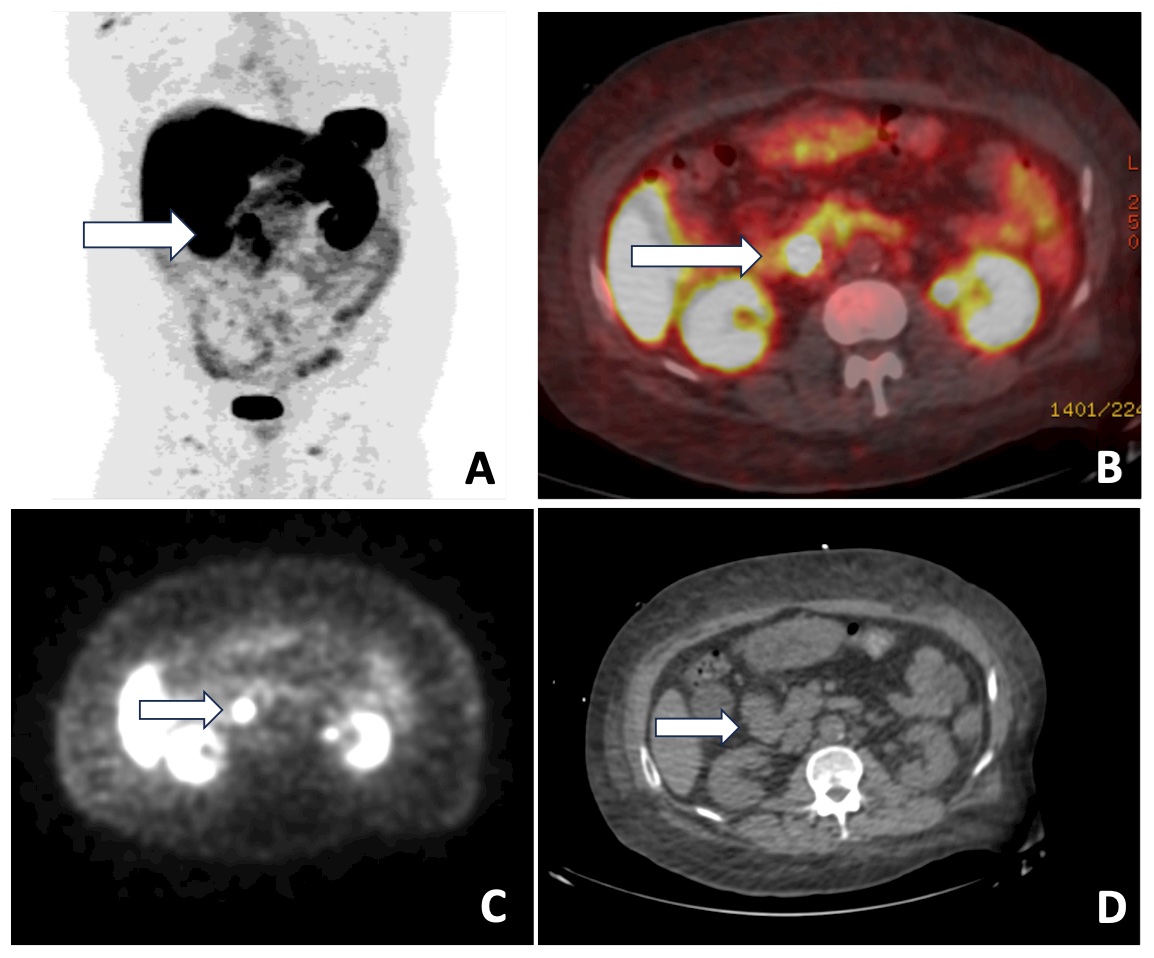Sunday Poster Session
Category: GI Bleeding
P0774 - Cardiac Arrest Due to Hemorrhagic Shock From a Gastrinoma-Related Hemorrhage
Sunday, October 27, 2024
3:30 PM - 7:00 PM ET
Location: Exhibit Hall E

Has Audio

Mary Camacho, BS
Emory University School of Medicine
Atlanta, GA
Presenting Author(s)
Mary Camacho, BS, Krishna Patel, MD, Nikita Desai, MD, Lucie Calderon, MD, Tanvi Dhere, MD, Nikrad Shahnavaz, MD, Patrick Arraj, MD
Emory University School of Medicine, Atlanta, GA
Introduction: Gastrinomas are neuroendocrine neoplasms that cause ectopic secretion of gastrin and subsequent acid hypersecretion—resulting in Zollinger-Ellison syndrome (ZES). ZES is commonly characterized by peptic ulcer disease and chronic diarrhea. Hemorrhagic shock and cardiac arrest due to gastrinoma-related bleeding ulcers have been reported, but it is uncommon.
Case Description/Methods: A 54-year-old male with GERD presented with chronic diarrhea and severe hypomagnesemia (< 0.5 mg/dL) after multiple admissions for the same issues. During a prior admission, his fasting gastrin level was elevated (579 pg/mL) and EGD showed Los Angeles (LA) grade C esophagitis; however, the patient was on a PPI when the gastrin level was checked. Given the high concern for ZES, he was discharged with plans to have gastrin level rechecked after 7 days off PPI therapy, but the patient was readmitted for worsening diarrhea and electrolyte derangements. He was admitted to the ICU twice during this admission due to hemorrhagic shock. Repeat EGD revealed worsening LA grade D esophagitis, large circumferential ulceration at the distal esophagus, diffuse gastritis with an antral ulcer, and duodenitis with several ulcers. Colonoscopy showed segmental colitis with ulceration, suggestive of ischemic colitis. A Gallium-68PET-scan was done that showed intense radiotracer avid focus in the third part of the duodenum without metastatic disease, concerning for gastrinoma. He was discharged with plans to undergo endoscopic ultrasound (EUS) for tissue sampling. EUS was aborted due to a distal esophageal stricture that prevented passage of the gastroscope. The following week, the patient was readmitted due to odynophagia and 40 lb weight loss. Several days after gastrostomy tube placement, he was transferred to the ICU for hemorrhagic shock resulting in cardiac arrest without successful resuscitation.
Discussion: Diagnosing ZES is challenging, but it is important to have a high suspicion in patients with GERD, peptic ulcers, and chronic diarrhea. Due to the nonspecific symptoms, diagnosis is often delayed, with an average time between onset of symptoms and final diagnosis longer than 5 years. Severe complications of ZES include bleeding, perforation, and stricture formation. Even though our patient did not have metastatic disease, delayed diagnosis of ZES lead to hemorrhagic shock and cardiac arrest—despite appropriate PPI therapy. Though PPI therapy can provide symptom control, surgical resection of the gastrinoma is curative.

Disclosures:
Mary Camacho, BS, Krishna Patel, MD, Nikita Desai, MD, Lucie Calderon, MD, Tanvi Dhere, MD, Nikrad Shahnavaz, MD, Patrick Arraj, MD. P0774 - Cardiac Arrest Due to Hemorrhagic Shock From a Gastrinoma-Related Hemorrhage, ACG 2024 Annual Scientific Meeting Abstracts. Philadelphia, PA: American College of Gastroenterology.
Emory University School of Medicine, Atlanta, GA
Introduction: Gastrinomas are neuroendocrine neoplasms that cause ectopic secretion of gastrin and subsequent acid hypersecretion—resulting in Zollinger-Ellison syndrome (ZES). ZES is commonly characterized by peptic ulcer disease and chronic diarrhea. Hemorrhagic shock and cardiac arrest due to gastrinoma-related bleeding ulcers have been reported, but it is uncommon.
Case Description/Methods: A 54-year-old male with GERD presented with chronic diarrhea and severe hypomagnesemia (< 0.5 mg/dL) after multiple admissions for the same issues. During a prior admission, his fasting gastrin level was elevated (579 pg/mL) and EGD showed Los Angeles (LA) grade C esophagitis; however, the patient was on a PPI when the gastrin level was checked. Given the high concern for ZES, he was discharged with plans to have gastrin level rechecked after 7 days off PPI therapy, but the patient was readmitted for worsening diarrhea and electrolyte derangements. He was admitted to the ICU twice during this admission due to hemorrhagic shock. Repeat EGD revealed worsening LA grade D esophagitis, large circumferential ulceration at the distal esophagus, diffuse gastritis with an antral ulcer, and duodenitis with several ulcers. Colonoscopy showed segmental colitis with ulceration, suggestive of ischemic colitis. A Gallium-68PET-scan was done that showed intense radiotracer avid focus in the third part of the duodenum without metastatic disease, concerning for gastrinoma. He was discharged with plans to undergo endoscopic ultrasound (EUS) for tissue sampling. EUS was aborted due to a distal esophageal stricture that prevented passage of the gastroscope. The following week, the patient was readmitted due to odynophagia and 40 lb weight loss. Several days after gastrostomy tube placement, he was transferred to the ICU for hemorrhagic shock resulting in cardiac arrest without successful resuscitation.
Discussion: Diagnosing ZES is challenging, but it is important to have a high suspicion in patients with GERD, peptic ulcers, and chronic diarrhea. Due to the nonspecific symptoms, diagnosis is often delayed, with an average time between onset of symptoms and final diagnosis longer than 5 years. Severe complications of ZES include bleeding, perforation, and stricture formation. Even though our patient did not have metastatic disease, delayed diagnosis of ZES lead to hemorrhagic shock and cardiac arrest—despite appropriate PPI therapy. Though PPI therapy can provide symptom control, surgical resection of the gastrinoma is curative.

Figure: A. PET DOTA showing increased uptake in region of duodenum (arrow), background physiologic uptake.
B. Fused PET-CT with increased uptake localizing to third portion of duodenum (arrow), consistent with gastrinoma.
C. Unfused PET DOTA with increased uptake localizing to the third portion of the duodenum (arrow).
D. Unfused CT with nonspecific thickening of third portion of duodenum (arrow).
B. Fused PET-CT with increased uptake localizing to third portion of duodenum (arrow), consistent with gastrinoma.
C. Unfused PET DOTA with increased uptake localizing to the third portion of the duodenum (arrow).
D. Unfused CT with nonspecific thickening of third portion of duodenum (arrow).
Disclosures:
Mary Camacho indicated no relevant financial relationships.
Krishna Patel indicated no relevant financial relationships.
Nikita Desai indicated no relevant financial relationships.
Lucie Calderon indicated no relevant financial relationships.
Tanvi Dhere indicated no relevant financial relationships.
Nikrad Shahnavaz indicated no relevant financial relationships.
Patrick Arraj indicated no relevant financial relationships.
Mary Camacho, BS, Krishna Patel, MD, Nikita Desai, MD, Lucie Calderon, MD, Tanvi Dhere, MD, Nikrad Shahnavaz, MD, Patrick Arraj, MD. P0774 - Cardiac Arrest Due to Hemorrhagic Shock From a Gastrinoma-Related Hemorrhage, ACG 2024 Annual Scientific Meeting Abstracts. Philadelphia, PA: American College of Gastroenterology.
